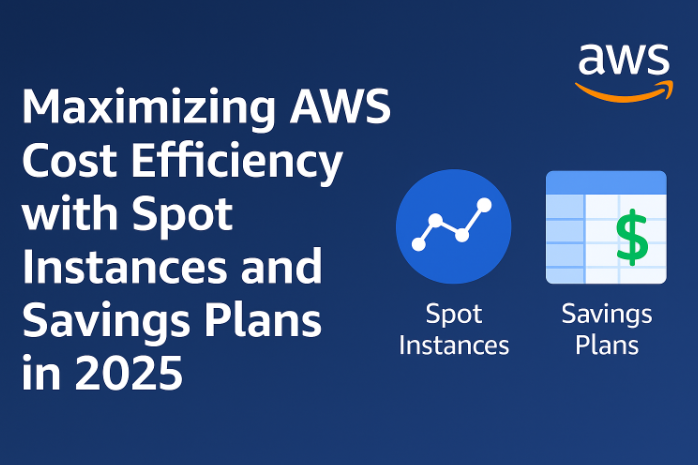
What Are Spot Instances and Savings Plans?
Before diving into the strategies for maximizing savings, it's important to understand the basics of Spot Instances and Savings Plans.
Spot Instances: These are unused EC2 instances that AWS offers at a significantly lower price compared to On-Demand Instances. Spot Instances can be terminated by AWS with little notice, making them ideal for flexible, fault-tolerant workloads.
Savings Plans: These are a flexible pricing model that offers lower prices in exchange for a commitment to use a certain amount of compute power (measured in $/hr) over one or three years. Savings Plans can be applied to various AWS services, including EC2, Fargate, and Lambda.
By using these two options effectively, businesses can dramatically reduce cloud costs, especially for workloads that are flexible in nature.
How AWS Spot Instances Work: Best Use Cases and Strategies
Spot Instances are typically the most cost-effective way to run EC2 instances. Here’s why:
Cost Savings: Spot Instances can be up to 90% cheaper than On-Demand Instances, depending on the instance type and region.
Ideal for Non-Critical Workloads: Spot Instances are perfect for workloads that are fault-tolerant, such as batch processing, machine learning training jobs, and data analysis tasks. If the instance is terminated, it won’t have a huge impact on operations.
Spot Instances Best Practices
To make the most of Spot Instances, follow these strategies:
Use Auto Scaling Groups: Automatically scale your Spot Instances with EC2 Auto Scaling. This ensures that you always have enough capacity to meet demand, even when Spot Instances are interrupted.
Diversify Instance Types and Regions: Spot prices vary based on instance types and regions. Using multiple instance types and regions can help you avoid price spikes and maximize savings.
Combine Spot Instances with On-Demand Instances: For critical workloads that need high availability, you can combine Spot Instances with On-Demand Instances in the same Auto Scaling Group. This hybrid approach can help you balance cost and reliability.
Use Spot Fleet: AWS Spot Fleet allows you to manage a pool of Spot Instances across multiple instance types and regions, improving the chances of maintaining capacity even if some Spot Instances are interrupted.
Common Use Cases for Spot Instances
Big Data Processing: Processing large datasets that don’t require real-time results. For instance, data ETL (Extract, Transform, Load) jobs.
Machine Learning: Training machine learning models that require large amounts of compute power and are fault-tolerant.
CI/CD Pipelines: Continuous Integration and Continuous Deployment pipelines, where intermittent interruptions don’t cause major issues.
How AWS Savings Plans Can Lower Long-Term Costs
While Spot Instances provide immediate savings, Savings Plans are the key to long-term cost reduction. Here’s how they work and why they’re worth considering:
Commitment for Savings: Savings Plans allow you to commit to a specific amount of usage (in $/hr) for 1- or 3-year terms. The longer the commitment, the greater the discount, with savings reaching up to 72% compared to On-Demand pricing.
Flexibility: Unlike Reserved Instances, Savings Plans are flexible. You can switch instance families, regions, operating systems, and tenancy without losing your discount. This flexibility is ideal for businesses that require flexibility in their cloud infrastructure.
Broad Coverage: Savings Plans can be applied to a wide range of AWS services, including EC2, Lambda, and Fargate. This makes them a versatile option for saving on compute costs across the board.
Savings Plans Best Practices
To get the most out of Savings Plans, follow these tips:
Assess Usage Patterns: Review your past AWS usage to predict your future needs. This will help you determine the appropriate commitment level (e.g., 1-year or 3-year term).
Consider Compute Requirements: If your business runs stable, predictable workloads, a Compute Savings Plan may be the best fit. For businesses with variable compute needs, an EC2 Instance Savings Plan might be better.
Combine with Spot Instances: Use Savings Plans for your steady, predictable workloads and Spot Instances for flexible, non-critical tasks. This strategy ensures you are saving on both fixed and flexible workloads.
Example: Savings from Combining Spot Instances and Savings Plans
Let’s consider a company running both steady-state workloads (e.g., web applications, databases) and dynamic workloads (e.g., batch processing, ML training). The company could:
Purchase a Savings Plan for its steady workloads to lock in long-term savings.
Use Spot Instances for the more flexible, dynamic workloads to reduce costs further.
By combining these two approaches, the company can maximize savings and keep performance high across all workloads.
Conclusion: How to Save and Scale Efficiently with AWS
AWS provides powerful tools like Spot Instances and Savings Plans that can significantly reduce your cloud costs when used correctly. By implementing these options, businesses can scale efficiently without compromising performance or flexibility.
To maximize savings in 2025, consider a hybrid approach that combines Savings Plans for predictable workloads and Spot Instances for flexible tasks. This approach allows businesses to achieve the best of both worlds: long-term savings and immediate cost reduction.
CloudFlew can help your business analyze usage patterns, optimize AWS cost management strategies, and provide tailored recommendations to ensure you maximize savings in 2025 and beyond. Contact us today for more information on AWS cost optimization!

